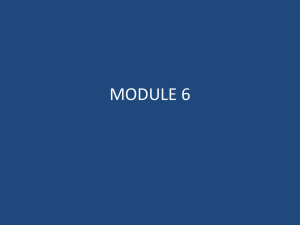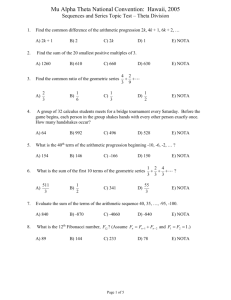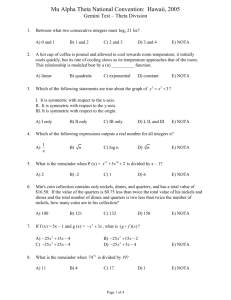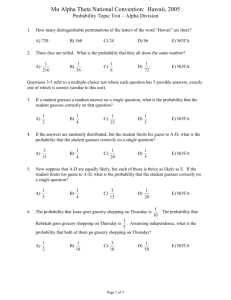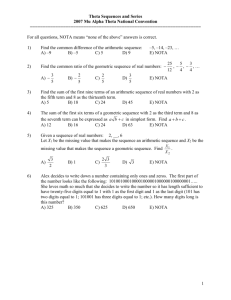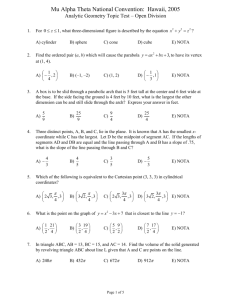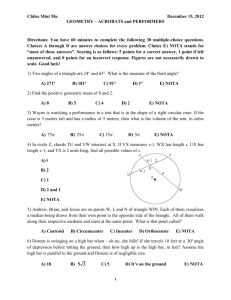Answer - Mu Alpha Theta
advertisement
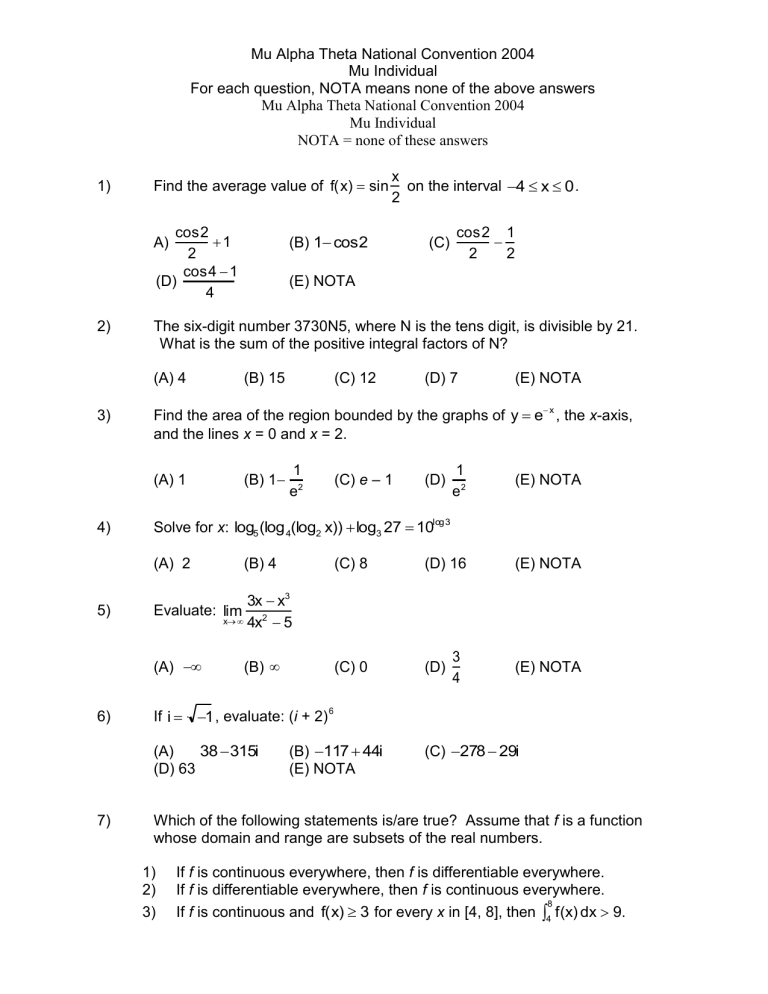
Mu Alpha Theta National Convention 2004 Mu Individual For each question, NOTA means none of the above answers Mu Alpha Theta National Convention 2004 Mu Individual NOTA = none of these answers 1) Find the average value of f(x) sin cos2 1 2 cos4 1 (D) 4 A) 2) (B) 1 1 e2 (D) 7 (E) NOTA 1 e2 (E) NOTA (C) 8 (D) 16 (E) NOTA (C) 0 (D) (C) e – 1 (B) 4 (D) 3x x3 x 4x2 5 Evaluate: lim If i (B) 1 , evaluate: (i + 2) (A) 38 315i (D) 63 7) (C) 12 Solve for x: log5 (log 4(log2 x)) log3 27 10log 3 (A) 6) cos2 1 2 2 Find the area of the region bounded by the graphs of y e x , the x-axis, and the lines x = 0 and x = 2. (A) 2 5) (C) (E) NOTA (B) 15 (A) 1 4) (B) 1 cos2 The six-digit number 3730N5, where N is the tens digit, is divisible by 21. What is the sum of the positive integral factors of N? (A) 4 3) x on the interval 4 x 0 . 2 3 4 (E) NOTA 6 (B) 117 44i (E) NOTA (C) 278 29i Which of the following statements is/are true? Assume that f is a function whose domain and range are subsets of the real numbers. 1) 2) 3) If f is continuous everywhere, then f is differentiable everywhere. If f is differentiable everywhere, then f is continuous everywhere. 8 If f is continuous and f(x) 3 for every x in [4, 8], then 4 f(x) dx 9. Mu Alpha Theta National Convention 2004 Mu Individual For each question, NOTA means none of the above answers (A) 2 only 8) 6 2 (B) 2 2 (C) 3 6 (B) 8 (C) 6 Simplify the following: /12 Evaluate: 0 (A) 12) 1 ln 3 2 (E) NOTA Evaluate: (D) 4 (E) NOTA (C) 2sin(2x) (B) 0 (E) NOTA dx cot(3x) (B) ln 2 6 (C) ln 3 2 (D) 1 (E) NOTA 1 2 1 1 1 1 2 3 4 3 8 6 (A) Diverges 13) 2 2 (D) sin(3x) cos(3x) . Assume nonzero denominators. sin x cosx (A) sin(2x) cos(2x) (D) 2 11) (E) NOTA When an infinitely thin circular plate of metal is heated in an oven, its radius starts increasing at a rate of 1 centimeter per second while still maintaining a circular shape. At what rate is the plate’s area increasing the moment its radius is 5 centimeters? Express your answer in square centimeters per second. (A) 10 10) (C) 1 and 3 (D) 1, 2, 3 What is the eccentricity of the ellipse with equation 4x2 8x 8y2 16y 52? (A) 9) (B) 1 and 2 (B) 15 2 Given the differential equation (C) 4 3 (D) 1 1 (B) ln 2e 2 (E) NOTA (E) NOTA 2 dy xe y x , find the value of y when x = 1, dx given that y = 0 when x = 0. e1/3 (A) ln 1 2 1 (D) 2 7 3 3 1 (C) ln 2 2e Mu Alpha Theta National Convention 2004 Mu Individual For each question, NOTA means none of the above answers 14) Seven coins are flipped behind a screen, and a reliable source tells you that at least two of them are heads. What is the probability that at most five of them are heads? (A) 15) 29 30 Find 16) 7 8 (C) 13 15 (D) 23 24 (E) NOTA dy for y xln x if x > 0. dx 2xln x ln x x (A) (D) (B) (C) (ln x)xlnx1 (B) xlnx2 xlnx ln x (E) NOTA Find the value of x2 y2 z2 , where x, y, and z satisfy the following system. x+y–z=8 2x – y = 3 y+z=6 (A) 38 17) (D) 107 (E) NOTA (B) 3 (C) 1 (D) 0 (E) NOTA A rectangular sheet of paper measures 48 decimeters by 55 decimeters. One corner is folded onto the diagonally opposite corner and then the paper is creased. The length of the crease is m / n decimeters, where m and n are relatively prime natural numbers. What is the value of m n ? (A) 7519 19) (C) 69 How many extrema (maximum or minimum) does the function 3 2 f(x) (x 3) (x 4) have on the interval 3 x 6 ? (A) 2 18) (B) 42 (B) 5320 (C) 4063 (D) 3559 (E) NOTA What is the volume of the solid generated when the region bounded by the graphs of y x3 , y = 0, y = 8, and the y-axis is rotated about the line x = 4? (A) 64 3 (B) 20 (C) 384 5 (D) 96 7 (E) NOTA Mu Alpha Theta National Convention 2004 Mu Individual For each question, NOTA means none of the above answers 20) Four hundred students answer a multiple-choice question with five possible choices. The students are in one of three sets A, B, or C. Set A knows the correct answer, Set B guesses incorrectly and Set C guesses correctly. The probability of a student guessing correctly is 1/5. If 180 of the 400 students give a wrong answer, then how many students knew the correct answer? (A) 175 21) (B) 145 (B) 5 26 (D) 13 4 (E) NOTA (B) 621.4 (C) 711.6 (D) 716.8 (E) NOTA (B) 8 2 3 (C) 26 3 (D) 10 16 3 (E) NOTA The sum of the sides of a right triangle is 540. The sides are in an arithmetic progression. What is the length of the hypotenuse? (B) 215 (C) 220 (D) 235 (E) NOTA Find the sum of the coordinates of the point in the graph of xy 2 x3y 6 that has a horizontal tangent line. (A) 1 26) (C) 1 (A) 210 25) 28 27 Evaluate: 0 (2x 1)2 sin(x) dx (A) 14 24) (E) NOTA Let N be a four digit number with no two of its digits the same and none of its digits zero. Let S be the sum of the digits of N. The maximum value possible for N S is what? (A) 608.2 23) (D) 135 Find the value of a + b + c + d so that the graph of y ax3 bx2 cx d has a relative minimum at (0, 0) and a relative maximum at (3, 4). (A) 1 22) (C) 185 (B) 2 (C) 3 (D) 4 (E) NOTA How many solutions are there to the equation cos x sin(2x) cos(3x) 0 , where x lies on the interval [2 ,2] ? (A) 15 (B) 13 (C) 11 (D) 9 (E) NOTA Mu Alpha Theta National Convention 2004 Mu Individual For each question, NOTA means none of the above answers 27) A solid has its base given by the region bounded by the graphs of y x , x = 0, x = 1, and the y-axis. If the cross sections of this solid perpendicular to the x-axis are in the shape of regular dodecagons, what is the volume of the solid? 4 (1 3 ) 3 (A) 28) (B) 5 2 8 64 (C) 3 3 3 16 32 (D) 2 2 4 (E) NOTA Let f(x) x2 2mx m , where x is a real number. Let r1 and r2 be the zeroes 2 2 3 3 of f (not necessarily distinct). Find the sum of all m such that r1 r2 r1 r2 . (A) 29) 5 4 (B) 1 (D) 1 2 (E) NOTA Let s be the sum of all distinct integer solutions to the equation 2 (x2 x 5) x 4x3 1. If f(x) (x 1)(x 2)(x 3) , find the value of f '(s) . (A) –3 30) 3 4 (C) (B) –2 (C) –1 (D) 0 (E) NOTA Which of the following mathematicians is most associated with the discovery of calculus? (A) Plato (B) Pythagoras (C) Newton (D) Napier (E) NOTA Tiebreaker #1 Let f(x) be a continuous and differentiable function. The table 1 below gives the value of f(x) and f’(x) at several values. Let g(x) = and f (x) h(x) = x3 + 2x. Find the value of the derivative of h(f(x)) at x = 1. x 1 f(x) -3 f’(x) -5 2 -8 -4 3 -9 3 4 0 16 Tiebreaker #2 Evaluate e x dx e x Mu Alpha Theta National Convention 2004 Mu Individual For each question, NOTA means none of the above answers Mu Alpha Theta National Convention 2004 Mu Individual Answers # 1 2 3 4 5 6 7 8 9 10 11 12 13 14 15 16 17 Answer C C B D A B E D A D B D E E A B A # 18 19 20 21 22 23 24 25 26 27 28 29 30 TB1 TB2 TB3 Answer D C E B B D E D B Thrown out A C C -145 /2 Mu Alpha Theta National Convention 2004 Mu Individual For each question, NOTA means none of the above answers 1) (C) Average value = 1 0 x cos2 1 . sin dx 4 0 (4) 2 2 2) (C) To be divisible by 21, the number has to be divisible by 3 and 7; thus 3 7 3 0 N 5 18 N has to be a multiple of 3. That means N has to be 0, 3, 6, or 9. It’s easy to just check each of these one by one to see if the original number is divisible by 7. It follows that 6 is the only one that works. The sum of the positive integral factors of 6 is 1+2+3+6= 12. 3) (B) Area = 0 ex dx e x 2 e 2 0 2 1. 4) (D) Since log3 27 3 and 10lo g3 3 , the equation reduces to log5 (log 4(log2 x))) 0 ; thus x2 45 0 2 41 16 . 5) (A) The degree of the numerator is bigger than the denominator’s so as x gets larger on the positive scale, the numerator dominates. Furthermore, since the numerator is negative and the denominator positive, the limit is . 6) (B) By the Binomial Theorem, 6 6 6 6 6 6 6 (i 2)6 i6 20 i5 2 i422 i3 23 i2 24 i125 i0 26 . Using the periodic 0 1 2 3 4 5 6 cycle of powers of i, the above simplifies to 117 44i . 7) (E) Statement 1 is false in general; for example, take f(x) | x | , which is continuous everywhere but is not differentiable at the origin. Statement 2 is true; it’s actually a theorem. Statement 3 is also true 8 8 because f(x) 3 implies 4 f(x) dx 4 3dx 12 9 . 16 8 2 (x 1)2 (y 1)2 8) (D) Complete the square to get . 1; the eccentricity is given by 2 16 8 16 9) (A) We have A r , so 2 dA 2 (5)(1) 10 . dt dA dr 2 r . Plug in all the known values to obtain dt dt Mu Alpha Theta National Convention 2004 Mu Individual For each question, NOTA means none of the above answers 10) (D) Combine the fractions and use trig. identities to get sin(3x) cosx cos(3x) sinx sin(3x x) 2sin(2x) 2. sinx cos x (1/ 2)sin(2x) sin(2x) 11) (B) /12 0 /12 dx /12 1 0 tan(3x)dx ln | sec(3x) | cot(3x) 3 0 1 1 lnsec ln(sec 0) 3 4 3 ln 2 1 1/2 1 1 ln 2 ln 2 3 3 2 6 1 1 and common ratio of ; its sum is 2 2 1/ 2 2 1 1. The even terms form a geometric series whose first term is and common ratio ; 1 1 / 2 3 2 2/3 4 4 7 . Altogether the sum is 1 . the sum of that is 1 1 / 2 3 3 3 12) (D) The odd terms form a geometric series with first term of 1 x2 y x 2 y 13) (E) Separate variables to obtain e dy xe dx ; thus e e C . Use the fact that the 2 1 1 1 curve passes through the origin to get C . Thus, when x 1, y ln . 2 2e 2 n! C(7,i) , where C(n,i) . Thus, 7 2 (n i)!i! P(2 X 5) (C(7,2) C(7,3) C(7,4) C(7,5)) / 27 14 . P(X 5 | X 2) 7 P(X 2) (C(7,2) C(7,3) C(7,4) C(7,5) C(7,6) C(7,7)) / 2 15 14) (E) If X is the number of heads, then P(X i) 15) (A) Take natural logs of both sides to obtain lny (ln x)2 . Differentiate implicitly and we have 1 dy 2ln x dy 2yln x 2xln x ln x . Thus, . y dx x dx x x 16) (B) Use your favorite technique of solving 3 x 3 systems to get (x,y,z) (4,5,1) ; thus 2 2 2 x y z 16 25 1 42. 17) (A) We’ll get extrema when the derivative is 0 or undefined. The derivative of f is f '(x) (x 4)(x 3)2 (5x 6) ; it’s obviously not undefined, but it equals 0 whenever x is –3, 4, or 6/5. Two of these values lie on the interval –3 < x < 6. Mu Alpha Theta National Convention 2004 Mu Individual For each question, NOTA means none of the above answers 18) (D) Let ABCD be a rectangle with AB = 48 and BC = 55. Fold the rectangle such that A coincides with C. Unfold the rectangle. Let EF be the crease, where E and F are on AD and BC, respectively. By symmetry, BF = ED = x. Now fold the rectangle again. Notice that the points A (which now coincides with C), E, and D make a right triangle with legs x and 48 with hypotenuse 55 – x. By the Pythagorean theorem, (55 x)2 x2 482 ; this yields x = 721/110. Now unfold the rectangle again. Notice the length of the crease L is the hypotenuse of a triangle with legs of 48 and 55 – 2x. Thus, 3504 721 2 L 482 (55 2x)2 482 (55 2(110 )) , making m + n = 3559. 55 2 384 3 19) (C) By the Shell Method, the volume is 2 0 (4 x)(8 x )dx . 5 20) (E) (CHANGED TO E) Set A knows; Set B guesses wrong; set C guesses right – 180 answer wrong P(guessing wrong) = 4/5 4/5 (# guessing) = 180 # guessing = 225 # guessing + # who knew = 400 # who knew = 400 – 225 = 175 21) (B) First things first, since the graph passes through the origin, d = 0. Now from the information given, y '(0) y '(3) 0 . Since y ' 3ax 2 2bx c , this makes c 0 and 2 0 3a(3) 2b(3) 27a 6b . The graph also passes through (3, 4), so 8 4 3 2 4 a(3) b(3) 27a 9b . Solving this yields (a,b) , ; thus 27 3 8 4 28 a b c d 00 . 27 3 27 22) (B) largest number on top / smallest number on bottom 9321/15 = 621.4 23) (D) The quickest way to do this problem is probably to use tabular integration: / u (2x 1) ] sin( x) 8x 4 ] 8 ] 0 dv 2 1 cos( x) 1 2 1 3 sin( x) cos( x) Multiply along the arrows to obtain an antiderivative: (2x 1)2 cos(x) (8x 4) sin(x) 8cos(x) . Use the Fundamental Theorem of Calculus to 2 3 obtain the answer in choice D. Mu Alpha Theta National Convention 2004 Mu Individual For each question, NOTA means none of the above answers 24) (E) 3x + 4x + 5x = 540 x = 45 135 + 180 + 225 = 540 1352 + 1802 = 2252 dy 3x2y y2 ; the curve will have a horizontal tangent dx 2xy x3 line when this quantity is 0. This occurs when 3x2y y2 y(3x2 y) 0 . If y 0 , then we have 2 3 2 x(0) x (0) 0 6 , a contradiction. Thus, 3x y ; plug this into the original equation to get 9x5 3x5 6 , or x 1, making y 3 . The sum of the coordinates is 4. 25) (D) Differentiating implicitly, we get that 26) (B) Regroup the equation as cos x cos(3x) sin(2x) 0 . Now use the sum-to-product identities on the first two terms to obtain 2sin(2x) sin(x) sin(2x) 0 , which simplifies to sin(2x)(2sinx 1) 0 . On the interval [2 ,2] , sin(2x) 0 has the solution set 5 11 7 3 , 2 . The equation 2sinx 1 0 has solutions , , , 0, , , . There 2 6 6 2 6 6 are 13 solutions in all. 27) (THROWN OUT) The formula for the area of a regular dodecagon with side length s is 3(2 3 )s2 ; one can derive this by breaking up the dodecagon into 12 isosceles triangles with vertex angle of 360/12 = 30 degrees and using some trigonometry. At any rate, since s y x , the 1 3 2 volume is equal to 0 3(2 3)( x) dx (2 3) . 2 28) (A) Recall the factorizations a2 b2 (a b)2 2ab and a3 b3 (a b)3 3ab(a b) . Since f is (2m) m 2m a b and m ab , a quadratic, the sum and product of the roots is given by 1 1 2 2 respectively. Thus, r1 r2 (2m)2 2(m) 4m2 2m and 3 3 3 3 2 r1 r2 (2m) 3(m)(2m) 8m 6m . Set these two quantities equal to each other to get (10) 5 . 8m3 10m2 2m 0 . The sum of the solutions to this equation is 8 4 29) (C) Let A x2 x 5 and B x2 4x 3 . Now for AB 1, we must have either A = 1 (and B can be anything), B = 0 (in this case A 0 ), or A 1 and B is even. The first case yields x being equal to –3 or 2. The second case yields x being equal to –3 or –1. The third case only produces noninteger values for B. Thus, the sum of all distinct solutions is s 3 1 2 2 . We have f '(x) (x 2)(x 3) (x 1)(x 3) (x 1)(x 2) , making f '(s) 0 (1)(1) 0 1 . 30) (C) Mu Alpha Theta National Convention 2004 Mu Individual For each question, NOTA means none of the above answers d h(x) h '(f (x))f '(x) (3(f (x))2 2)f '(x) dx Tiebreaker #1 -145 d h(1) (3(3)2 2)(5) 145 dx 2 b 0 dx e xdx e xdx lim 2x lim x x b 1 a a e 2x 1 e e 0 e b lim arctan e x lim arctan e x Tiebreaker #2 b+ 0 lim (arctan e b a 0 a ) lim ( arctan e a ) b 4 a 4 0 2 4 4 2
